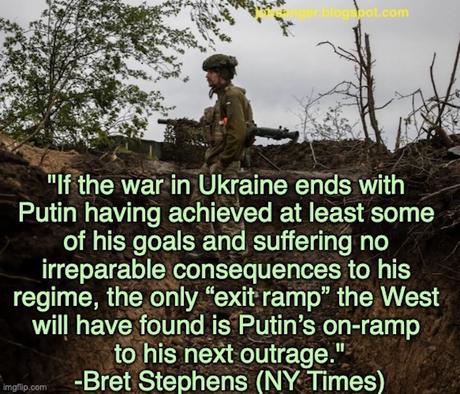
There has been a lot of talk about a diplomatic solution for the war in Ukraine. That's hogwash. If Putin is allowed to keep even an inch of the territory he has seized, it will just encourage more Russian aggression in the future. The only acceptable solution is a Ukrainian victory!
Here is how Bret Stephens describes it in The New York Times:
It may be that Ukraine’s long-awaited counteroffensive, which could be in its early stages, will be as fruitless as Russia’s winter offensive. Defenders typically have advantages over attackers in trench warfare, and the Russian Army has had months to dig in.
But it’s also possible that the Ukrainians could achieve breakthroughs that could put the end of the war in sight this year. What then? How should this end?
We can start by listing the ways in which it shouldn’t. The first is the one suggested last year by President Emmanuel Macron of France. “We must not humiliate Russia,” he argued, “so that the day when the fighting stops we can build an exit ramp through diplomatic means.” At the time, to “not humiliate Russia” was code for allowing Russia to preserve its ill-gotten gains while it was on the offensive.
Wrong. A crushing and unmistakable defeat is precisely what is necessary to put an end to Russia’s imperialistic ambition. It’s easy to forget now that last year’s invasion was the third time Vladimir Putin had launched a war of conquest, intimidation and annexation against his neighbors, following the invasion of Georgia in 2008 and the seizure of Ukrainian soil in 2014. And that’s not counting cyberwarfare against Estonia, assassinations on British soil, the downing of Malaysia Airlines Flight 17, or the annihilation of Aleppo and Grozny
Each act of aggression went essentially unpunished, tempting Russia into the next one. If the war in Ukraine ends with Putin having achieved at least some of his goals and suffering no irreparable consequences to his regime, the only “exit ramp” the West will have found is Putin’s on-ramp to his next outrage.
Similarly, if Ukrainian forces break through Russian lines in a way that prompts Putin to seek a settlement — probably through Chinese mediation — there will be those who argue that a cease-fire and armistice on the Korean model is preferable to the risks of a dramatic escalation. The Kremlin may try to encourage this line of thinking by again rattling its nuclear saber, this time even louder.
But while the nuclear threat should never be discounted, it looks empty on close inspection.
The reason Putin hasn’t used tactical nuclear weapons in this war thus far isn’t because of moral scruples that might vanish if he feels cornered. It’s because those weapons, which were originally designed to destroy large concentrations of armor, make little sense on a thinly spread battlefield. And because the Biden administration has threatened unspecified “catastrophic consequences” if Russia uses such weapons — perhaps involving the sinking of Russia’s Black Sea fleet or some other kinetic but non-nuclear NATO response.
The larger problem with the armistice model is that it freezes the conflict in a way that would allow Russia to resume it once it has licked its wounds and regained its strength. As for Ukraine, it would have to become a garrison state even as its economy has been crippled by the war. Those who make the South Korea analogy neglect two things. First, Russia is intrinsically a more powerful state than North Korea. Second, peace on the Korean Peninsula has been preserved by a large and continuous 70-year U.S. military presence — one that relatively few Americans would have an appetite to duplicate in Ukraine.
The alternative is winning. It is what Ukrainians deserve, what the overwhelming majority want and what they demand from their political leadership. The goal has been both hindered and advanced by President Biden’s fluctuating willingness to provide Kyiv with the tools it needs to win. It has also been stymied by his own ambivalence about the outcome he really desires, other than to not let Russia win and to not blow up the world in the process.
Winning comes in two flavors. The first, and riskier, is to provide Kyiv with the weapons it needs — mainly long-range guided missiles, more tanks, Predator drones and F-16s — not only to push Russia out of the territories it seized in this war, but to retake Crimea and the breakaway “republics” in the east. This is what Ukrainians want, and what they are morally and legally entitled to.
But retaking Crimea will be hard, and even success will come with costs, primarily in the form of populations that aren’t necessarily eager to be liberated by Kyiv. Hence the second flavor: To help Ukraine restore its pre-February 2022 borders, but no further — with compensation in the form of membership in the European Union and a bilateral U.S.-Ukraine security treaty modeled on America’s security cooperation with Israel.
Would this increase America’s exposure to Russian aggression? No, it would diminish it, for the same reason Putin didn’t dare attack the NATO-member Baltic States but twice attacked Ukraine: Dictators prey on the weak, not the strong. Would it satisfy Ukraine’s need for security? Yes, both in guaranteed access to Europe’s markets and America’s arms.
And would it humiliate Putin? In the best way possible, by showing him and other despots, within and beyond Russia, that aggression against democracies never pays.

